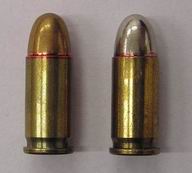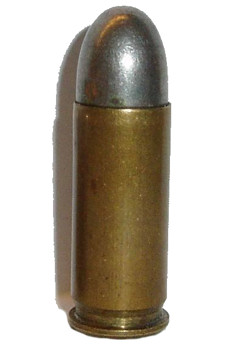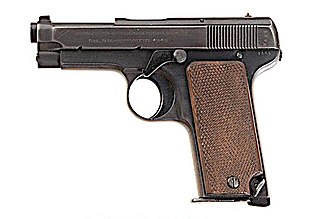
A revolver is a repeating handgun that has at least one barrel and uses a revolving cylinder containing multiple chambers for firing. Because most revolver models hold up to six cartridges before needing to be reloaded, revolvers are also commonly called six shooters.

The M1911 is a single-action, recoil-operated, semi-automatic pistol chambered for the .45 ACP cartridge. The pistol's formal U.S. military designation as of 1940 was Automatic Pistol, Caliber .45, M1911 for the original model adopted in March 1911, and Automatic Pistol, Caliber .45, M1911A1 for the improved M1911A1 model which entered service in 1926. The designation changed to Pistol, Caliber .45, Automatic, M1911A1 in the Vietnam War era.
A semi-automatic firearm, also called a self-loading or autoloading firearm, is a repeating firearm whose action mechanism automatically loads a following round of cartridge into the chamber (self-loading) and prepares it for subsequent firing, but requires the shooter to manually actuate the trigger in order to discharge each shot. Typically, this involves the weapon's action utilizing the excess energy released during the preceding shot to unlock and move the bolt, extracting and ejecting the spent cartridge case from the chamber, re-cocking the firing mechanism, and loading a new cartridge into the firing chamber, all without input from the user. To fire again, however, the user must actively release the trigger, allow it to "reset", before pulling the trigger again to fire off the next round. As a result, each trigger pull only discharges a single round from a semi-automatic weapon, as opposed to a fully automatic weapon, which will shoot continuously as long as the ammunition is replete and the trigger is kept depressed.

A semi-automatic pistol is a handgun that automatically ejects and loads cartridges in its chamber after every shot fired. Only one round of ammunition is fired each time the trigger is pulled, as the pistol's fire control group disconnects the trigger mechanism from the firing pin/striker until the trigger has been released and reset.

The .45 ACP or .45 Auto (11.43×23mm) is a rimless straight-walled handgun cartridge designed by John Moses Browning in 1904, for use in his prototype Colt semi-automatic pistol. After successful military trials, it was adopted as the standard chambering for Colt's M1911 pistol. The round was developed due to a lack of stopping power experienced in the Moro Rebellion in places like Sulu. The issued ammunition, .38 Long Colt, had proved inadequate, motivating the search for a better cartridge. This experience and the Thompson–LaGarde Tests of 1904 led the Army and the Cavalry to decide that a minimum of .45 caliber was required in a new handgun.

.32 ACP is a centerfire pistol cartridge. It is a semi-rimmed, straight-walled cartridge developed by firearms designer John Browning, initially for use in the FN M1900 semi-automatic pistol. It was introduced in 1899 by Fabrique Nationale, and is also known as the 7.65×17mmSR Browning or 7.65 mm Browning Short.

The Webley Revolver was, in various designations, a standard issue service pistol for the armed forces of the United Kingdom, and countries of the British Empire and the Commonwealth of Nations, from 1887 to 1970.

Webley & Scott is an arms manufacturer founded in Birmingham, England. Webley produced handguns and long guns from 1834 to 1979, when the company ceased to manufacture firearms and instead turned its attention to producing air pistols and air rifles. In 2010 Webley & Scott restarted the production of shotguns for commercial sale.

A magazine is an ammunition storage and feeding device for a repeating firearm, either integral within the gun or externally attached. The magazine functions by holding several cartridges within itself and sequentially pushing each one into a position where it may be readily loaded into the barrel chamber by the firearm's moving action. The detachable magazine is sometimes colloquially referred to as a "clip", although this is technically inaccurate since a clip is actually an accessory device used to help load ammunition into a magazine.

The .38 S&W, also commonly known as .38 S&W Short, 9×20mmR, .38 Colt NP , or .38/200, is a revolver cartridge developed by Smith & Wesson in 1877. Versions of the cartridge were the standard revolver cartridges of the British military from 1922 to 1963. Though similar in name, it is not interchangeable with the later .38 Special due to a different case shape and slightly larger bullet diameter.

.455 Webley is a British handgun cartridge, most commonly used in the Webley top break revolvers Marks I through VI. It is also known as ".455 Eley" and ".455 Colt".

The Enfield Revolver was a self-extracting British handgun designed and manufactured at the government-owned Royal Small Arms Factory in Enfield, initially in the .476 calibre.

The Webley–Fosbery Self-Cocking Automatic Revolver is a recoil-operated automatic revolver designed by Lieutenant Colonel George Vincent Fosbery VC and produced by the Webley & Scott company from 1901 to 1924. The revolver is easily recognisable by the zig-zag grooves on the cylinder.

The .38 ACP, also known as the .38 Auto or 9x23mmSR, is a semi-rimmed pistol cartridge that was introduced at the turn of the 20th century for the John Browning-designed Colt M1900. It was first used in Colt's Model 1897 prototype, which he did not produce. The metric designation for the round is 9×23mm SR (semi-rimmed), which is not to be confused with other 9×23mm cartridges.

A service pistol, also known as a personal weapon or an ordnance weapon, is any handgun issued to regular military personnel or law enforcement officers. Typically, service pistols are revolvers or semi-automatic pistols issued to officers, non-commissioned officers, and rear-echelon support personnel for self-defense, though service pistols may also be issued to special forces as a backup for their primary weapons. Pistols are not typically issued to front-line infantry. Before firearms were commonplace, officers and non-commissioned officers typically carried swords instead.

The Beaumont–Adams revolver is a black powder, double-action, percussion revolver. Originally adopted by the British Army in .442 calibre in 1856, it was replaced in British service in 1880 by the .476 calibre Enfield Mk I revolver.

The Colt New Service is a large frame, large caliber, double-action revolver made by Colt from 1898 until 1941. Made in various calibers, the .45 Colt version with a 5½" barrel, was adopted by the U.S. Armed Forces as the Model 1909.

The .476 Enfield, also known as the .476 Eley, .476 Revolver, and occasionally .455/476, is a British centrefire black powder revolver cartridge. The Enfield name derives from the location of the Royal Small Arms Factory at Enfield Lock, the armoury where British military small arms were produced, while Eley was a British commercial brand. Used in the Enfield Mk II revolver, the Mk III variant was introduced by the British Army in 1881, supplanting the earlier .476 Enfield Mark I and II cartridges, which in turn had replaced the .450 Adams cartridges, all of which also used black powder propellant.

The Enfield No. 2 was a British top-break revolver using the .38 S&W round manufactured from 1930 to 1957. It was the standard British/Commonwealth sidearm in the Second World War, alongside the Webley Mk IV and Smith & Wesson Victory Model revolvers chambered in the same calibre.

The Beretta Model 1915 or Beretta M1915 is a semi-automatic pistol manufactured by Beretta, designed by Tullio Marengoni who was the chief engineer in the company, to replace the Glisenti Model 1910 which had a complex and weak firing mechanism. It is the first semi-automatic pistol which was manufactured by the company, and issued as a service pistol in Royal Italian Army during World War I. The total production of the Beretta M1915 is estimated about 15,670 during 1915-1918, and about 56,000 of Beretta M1915/1917. Some of the pistols were also used in World War II until 1945. The design of the pistol is similar to modern Beretta pistols such as Beretta M1923, Beretta M1934, Beretta M1935, Beretta M1951, Beretta 70, Beretta 92, Beretta Cheetah, and Beretta M9.



















